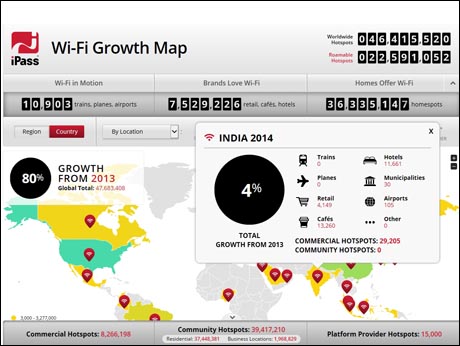
'Messy, fragmented' WiFi scene worldwide; 29,000+ in India; soon 60% of planes will offer WiFi
Redwood Shores(CA, USA): December10 2014–The world’s largest commercial Wi-Fi network, iPass Inc., has published the results of research into global public Wi-Fi hotspot deployments in the form of a WiFi Growth Map.
The data, from analysts Maravedis Rethink, shows there will be 47.7 million public Wi-Fi hotspots deployed worldwide by the end of 2014. The map shows that over the next four years, global hotspot numbers will grow to over 340 million; nearly one Wi-Fi hotspot for every twenty people on earth by 2018. This compares to one Wi-Fi hotspot for every 150 people today.
WiFi will be available on 60% of planes and 11% of trains by 2018.
Acording to the map, there are just under 30,000 commercial hotspots in India, up 4% from 2013. The map highlights:
France is the “country of Wi-Fi” in 2014 with the most hotspots in total, followed by the USA and the UK. By 2018 this will change to the USA, followed by China and France.
Europe is the “continent of Wi-Fi” with 50% of the world’s Wi-Fi estate in 2014. By 2018, Asia will strip Europe of this title.
Today, China has 5 times more commercial Wi-Fi hotspots than any other country.
Community Wi-Fi has been driven by Europe and then North America, but Asia will catch up in 2018.
“Over the last few years we’ve seen the emergence of the ‘Wi-Fi first’ generation. Wi-Fi has become cool again; in fact it’s seen by most as an essential utility, just like water or electricity,” said Evan Kaplan, President and CEO of iPass. “Most of the devices we use are Wi-Fi only and even on the most advanced 4G handsets, 78% of data goes over Wi-Fi. Simply put, it’s the network of choice for consumers and soon they’ll be able to roam this alternative network of millions of hotspots.”
Wi-Fi is also on the move, becoming available on 60% of planes and 11% of trains by 2018. This compares to only 16% of planes and 3% of trains equipped with Wi-Fi in 2014. Community ‘homespot’ public Wi-Fi hotspots will see the most explosive growth, rising from just under 40 million in 2014 to over 325 million in 2018.
“The growth in community hotspots is taking public Wi-Fi from the cities to the suburbs. The fixed line operators with superfast broadband in the ground are converting residential customers to community hotspot providers at the rate of 1 per second. For many years, all the talk around mobility has been on 3G/4G and a handful of mobile operators. Our data shows that in the coming years it’s Wi-Fi that will steal the limelight as consumers thirst for data goes beyond anything that cellular can deliver, and as business owners see the value Wi-Fi brings to helping them differentiate and innovate,” said Peter White, co-founder, Maravedis Rethink.
The Wi-Fi Revolution
The research showed that Wi-Fi is changing the power structures of the telecommunications industry. 50% of all commercial hotspots are controlled by brands whose core business isn’t telecommunications. Just a few years ago there were only a handful of Wi-Fi suppliers, now there are millions. As opposed to the highly-regulated cellular world, Wi-Fi is organic, emergent and empowering; it’s not regulated and it’s easy for anyone to deploy. As a result, we are witnessing a power shift from traditional telcos to business owners, such as cafes, hoteliers and retailers who are all getting in on the Wi-Fi game.
“A messy and fragmented global Wi-Fi network is emerging; the challenge is that it needs to be easy for consumers to access and simple for providers to monetize. This is where we’ll see the platform players like Facebook and Google come to the party. They have the ability to help this new breed of Wi-Fi provider get paid in meaningful currencies – namely cash, advertising or user data,” Kaplan added.